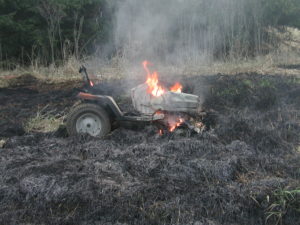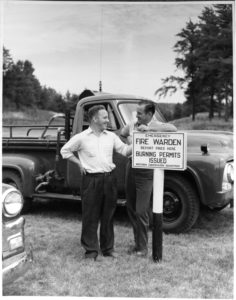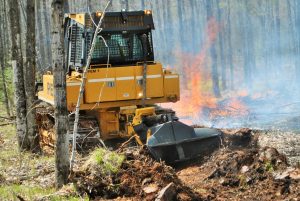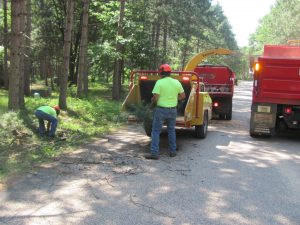by Catherine Koele, wildfire prevention specialist, Wisconsin DNR
It’s no surprise that the number one cause of wildfires in Wisconsin is from human carelessness. What is surprising is that the peak of fire season is in the spring, shortly after the snow-cover disappears and just before vegetation greens-up. Many individuals this time of year are outdoors burning leaves, brush and pine needles from their annual yard clean-up. All too often, this method of debris disposal can spark a wildfire.

This lawn mower caused a wildfire while operating on dry vegetation during elevated fire conditions. Proper maintenance could have prevented this fire.
The reality is, there are numerous other ways a wildfire can occur, such as campfires, fireworks and ashes from woodstoves. A close second behind debris burning is equipment. Nearly 20% of all wildfires in Wisconsin are caused by activities such as logging and farm operations, hot exhaust systems from vehicles, recreational vehicles, such as ATV’s or motorcycles, operating without spark arresters or even simple things like dragging chains from trailers.
Most of these fires can be prevented by doing routine maintenance on equipment to ensure machinery is clean from debris or carbon build-up and checking tire pressure and brakes to avoid metal-to-metal contact. Taking the time to look around before parking hot exhaust systems or pipes in dry, grassy areas can also make a difference. And, getting an early start with any logging and farm operations during times of elevated fire danger. This can greatly decrease your chances of starting a wildfire since temperatures are warmer, humidity decreases and winds are gustier in the afternoon which can lead to rapid fire spread. Continue reading “Wildfire prevention week – spark a change, not a wildfire”

 A Smokey Bear sighting in Oneida County this week. This highly recognizable symbol of fire prevention has finally awakened from hibernation, just in time for ‘Wildfire Prevention Week,’ April 15-21. Spring is Wisconsin’s peak season for wildfires. Warm, windy and dry conditions have resulted in over 160 wildfires in the southern half of the state this year, as the snow-melt is slowly progressing to the north. Don’t worry. Smokey is very approachable, friendly and loves to give bear hugs. Do your part to help Smokey by getting a free
A Smokey Bear sighting in Oneida County this week. This highly recognizable symbol of fire prevention has finally awakened from hibernation, just in time for ‘Wildfire Prevention Week,’ April 15-21. Spring is Wisconsin’s peak season for wildfires. Warm, windy and dry conditions have resulted in over 160 wildfires in the southern half of the state this year, as the snow-melt is slowly progressing to the north. Don’t worry. Smokey is very approachable, friendly and loves to give bear hugs. Do your part to help Smokey by getting a free 

 Wisconsin has already had more than 200 wildfires in 2017 since the snow-cover disappeared with the potential of more before vegetation greens up and the fire danger subsides.
Wisconsin has already had more than 200 wildfires in 2017 since the snow-cover disappeared with the potential of more before vegetation greens up and the fire danger subsides.